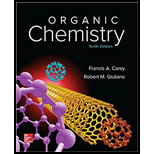
ORGANIC CHEMISTRY (LOOSELEAF)-PACKAGE
10th Edition
ISBN: 9781260008562
Author: Carey
Publisher: MCG
expand_more
expand_more
format_list_bulleted
Concept explainers
Question
Chapter 24.4, Problem 4P
Interpretation Introduction
Interpretation:
The D, L configuration, the R, S configuration at the chirality center with the highest number of the given aldose are to be determined. The sign of rotation of the aldose is also to be predicted.
Concept introduction:
A carbon atom that has four non-equivalent atoms or groups attached to it is known as a chiral carbon atom (or asymmetric or stereogenic centers).
The naming of a chiral center and geometric isomers are based on Cahn-Ingold-Prelog priority rules.
The D and L configuration are the spatial arrangement of the molecules about the chirality center of the carbohydrates.
Expert Solution & Answer
Want to see the full answer?
Check out a sample textbook solution
Students have asked these similar questions
Provide the reasonable steps to achieve the following synthesis.
Identify which compound is more acidic. Justify your choice.
Provide the reasonable steps to achieve the following synthesis.
Chapter 24 Solutions
ORGANIC CHEMISTRY (LOOSELEAF)-PACKAGE
Ch. 24.2 - Prob. 1PCh. 24.3 - Problem 24.2 Which aldotetrose in the structure...Ch. 24.4 - Prob. 3PCh. 24.4 - Prob. 4PCh. 24.6 - Prob. 5PCh. 24.6 - Prob. 6PCh. 24.7 - Prob. 7PCh. 24.8 - Prob. 8PCh. 24.8 - Prob. 9PCh. 24.9 - Prob. 10P
Ch. 24.10 - Prob. 11PCh. 24.10 - Prob. 12PCh. 24.11 - Prob. 13PCh. 24.12 - Prob. 14PCh. 24.14 - Prob. 15PCh. 24.14 - Prob. 16PCh. 24.14 - Prob. 17PCh. 24.14 - Using Mechanism 24.2 as a guide, write a stepwise...Ch. 24.15 - Prob. 19PCh. 24.17 - Prob. 20PCh. 24.17 - Prob. 21PCh. 24.18 - Prob. 22PCh. 24.18 - Prob. 23PCh. 24.18 - Prob. 24PCh. 24.20 - Prob. 25PCh. 24 - Prob. 26PCh. 24 - Prob. 27PCh. 24 - Prob. 28PCh. 24 - Prob. 29PCh. 24 - Prob. 30PCh. 24 - Prob. 31PCh. 24 - Prob. 32PCh. 24 - Prob. 33PCh. 24 - Prob. 34PCh. 24 - Prob. 35PCh. 24 - Methyl glycosides of 2-deoxy sugars have been...Ch. 24 - Prob. 37PCh. 24 - Prob. 38PCh. 24 - Prob. 39PCh. 24 - Prob. 40PCh. 24 - Treatment of d-mannose with methanol in the...Ch. 24 - Prob. 42PCh. 24 - Prob. 43PCh. 24 - Prob. 44PCh. 24 - Prob. 45DSPCh. 24 - Prob. 46DSPCh. 24 - Prob. 47DSPCh. 24 - Prob. 48DSPCh. 24 - Prob. 49DSP
Knowledge Booster
Learn more about
Need a deep-dive on the concept behind this application? Look no further. Learn more about this topic, chemistry and related others by exploring similar questions and additional content below.Similar questions
- When anisole is treated with excess bromine, the reaction gives a product which shows two singlets in 1H NMR. Draw the product.arrow_forward(ii) Draw a reasonable mechanism for the following reaction: CI NaOH heat OH (hint: SNAr Reaction) :arrow_forwardDraw the major product in each of the following reaction:arrow_forward
- Draw the mechanism for the following Friedel-Craft reaction. AlBr3 Brarrow_forward(a) Draw the structures of A and B in the following reaction. (i) NaNH2, NH3(1) A + B (ii) H3O+arrow_forwardFor the reaction 2 N2O5(g) → 4 NO2(g) + O2(g), the following mechanism has been proposed: N2O5 →> NO₂+ NO3_(K1) NO2 + NO3 → N2O5 (k-1) NO2 + NO3 → → NO2 + O2 + NO (K2) NO + N2O5- NO2 + NO2 + NO2 (K3) d[N₂O5] __2k‚k₂[N2O5] Indicate whether the following rate expression is acceptable: dt k₁₁+ k₂arrow_forward
- Consider the following decomposition reaction of N2O5(g): For the reaction 2 N2O5(g) → 4 NO2(g) + O2(g), the following mechanism has been proposed: N2O5 → NO2 + NO3 (K1) NO2 + NO3 → N2O5 (k-1) NO2 + NO3 → NO2 + O2 + NO (K2) NO + N2O5 → NO2 + NO2 + NO2 (K3) Indicate whether the following rate expression is acceptable: d[N2O5] = -k₁[N₂O₂] + K¸₁[NO₂][NO3] - K¸[NO₂]³ dtarrow_forwardIn a reaction of A + B to give C, another compound other than A, B or C may appear in the kinetic equation.arrow_forwardFor the reaction 2 N2O5(g) → 4 NO2(g) + O2(g), the following mechanism has been proposed: N2O5 →> NO₂+ NO3_(K1) NO2 + NO3 → N2O5 (k-1) NO2 + NO3 → → NO2 + O2 + NO (K2) NO + N2O5- NO2 + NO2 + NO2 (K3) d[N₂O5] __2k‚k₂[N2O5] Indicate whether the following rate expression is acceptable: dt k₁₁+ k₂arrow_forward
- Given the reaction R + Q → P, indicate the rate law with respect to R, with respect to P and with respect to P.arrow_forwardSteps and explanations. Also provide, if possible, ways to adress this kind of problems in general.arrow_forwardk₁ Given the reaction A B, indicate k-1 d[A] (A). the rate law with respect to A: (B). the rate law with respect to B: d[B] dt dtarrow_forward
arrow_back_ios
SEE MORE QUESTIONS
arrow_forward_ios
Recommended textbooks for you
